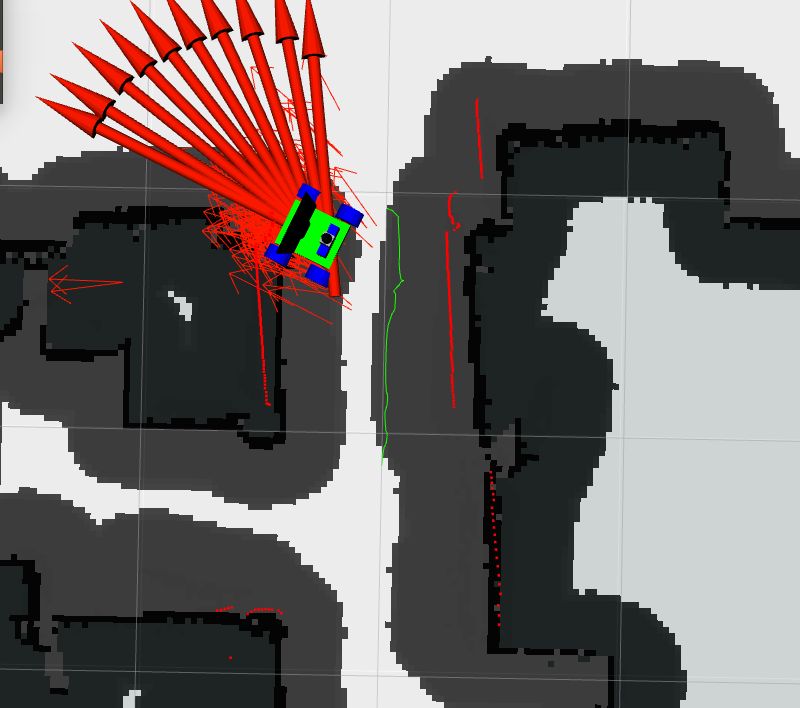Hello,
I try to make my real robot navigate through some narrow passways (70cm) (robot 40cm wide), but no matter what paramaters i change the robot doesnt respect the inflation and doesnt correct it’s course when near walls
My odom and amcl although not perfect, i think are pretty good odom (test by setting the decay time for the laser e.q 20) ideally the scans should align
bump into wall test (move base):
P.S with dwa local planner which is the defacto the robot rotates so i use Trajectory planner, maybe by fixing this problem i can use dwa after P.S also the local costmap i can visualize only with map scheme or raw but no costmap? weird ,i think i can see the inflation layer of new obstacles
Any help to increase the robustness of move base to navigate in tight corridors welcome
Thanks so much for your time!!
config of move base and amcl code below:
Base global planner
recovery_behaviour_enabled: true
#controller_frequency: 2
NavfnROS:
allow_unknown: false # Specifies whether or not to allow navfn to create plans that traverse unknown space.
default_tolerance: 0.2 # A tolerance on the goal point for the planner.
Base local planner
recovery_behaviour_enabled: true
TrajectoryPlannerROS:
# Robot Configuration Parameters
acc_lim_x: 0.5
acc_lim_theta: 0.5
max_vel_x: 0.17
min_vel_x: 0.11
max_vel_theta: 0.11
min_vel_theta: 0.075
max_in_place_vel_theta: 0.11
min_in_place_vel_theta: 0.075
holonomic_robot: false
escape_vel: -0.1
# Goal Tolerance Parameters
yaw_goal_tolerance: 0.15
xy_goal_tolerance: 0.15
latch_xy_goal_tolerance: true
# Forward Simulation Parameters
sim_time: 2
sim_granularity: 0.02
angular_sim_granularity: 0.02
vx_samples: 10
vtheta_samples: 25
controller_frequency: 20.0
# Trajectory scoring parameters
meter_scoring: true # Whether the gdist_scale and pdist_scale parameters should assume that
goal_distance and path_distance are expressed in units of meters or cells. Cells are assumed by default (false).
occdist_scale: 0.2 #The weighting for how much the controller should attempt to avoid obstacles. default 0.01
pdist_scale: 1.5 # The weighting for how much the controller should stay close to the path it was given . default 0.6
gdist_scale: 1.5 # The weighting for how much the controller should attempt to reach its local goal, also controls speed default 0.8
heading_lookahead: 0.1 #How far to look ahead in meters when scoring different in-place-rotation trajectories
heading_scoring: false #Whether to score based on the robot's heading to the path or its distance from the path. default false
heading_scoring_timestep: 0.4 #How far to look ahead in time in seconds along the simulated trajectory when using heading scoring
dwa: false #Whether to use the Dynamic Window Approach (DWA)_ or whether to use Trajectory Rollout
simple_attractor: false
publish_cost_grid_pc: true
# Oscillation Prevention Parameters
oscillation_reset_dist: 0.1 #How far the robot must travel in meters before oscillation flags are reset (double, default: 0.05)
escape_reset_dist: 0.2
escape_reset_theta: 0.2
Costmap common Paramaters
footprint: [[-0.175, -0.175], [-0.175, 0.175], [0.175, 0.175], [0.175, -0.175]]
footprint_padding: 0.05
map_type: costmap
obstacle_range: 3
raytrace_range: 3.5
transform_tolerance: 0.5
min_obstacle_height: 0.0
max_obstacle_height: 0.3
#layer definitions
static:
enable: true
map_topic: /map
obstacles_laser:
enabled: true
observation_sources: laser
laser: {data_type: LaserScan, clearing: true, marking: true, topic: /scan, inf_is_valid: true}
inflation:
enabled: true
inflation_radius: 0.25
cost_scaling_factor: 1
Global costmap paramaters
global_costmap:
global_frame: map
robot_base_frame: robot_footprint
update_frequency: 5
publish_frequency: 0.5
width: 20.0
height: 20.0
resolution: 0.05
static_map: true
track_unknown_space: false
rolling_window: false
plugins:
- {name: static, type: "costmap_2d::StaticLayer"}
- {name: obstacles_laser, type: "costmap_2d::VoxelLayer"}
- {name: inflation, type: "costmap_2d::InflationLayer"}
Local costmap paramaters
local_costmap:
global_frame: odom
robot_base_frame: robot_footprint
update_frequency: 10
publish_frequency: 4.0
width: 2.0
height: 2.0
resolution: 0.02
static_map: false
rolling_window: true
plugins:
- {name: obstacles_laser, type: "costmap_2d::ObstacleLayer"}
- {name: inflation, type: "costmap_2d::InflationLayer"}
 and the skid_steering_controller is not a good representation of how my robot behaves .
and the skid_steering_controller is not a good representation of how my robot behaves .